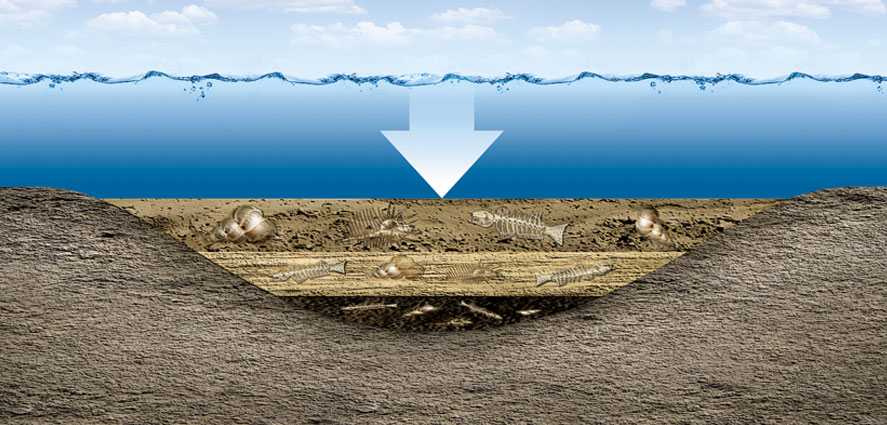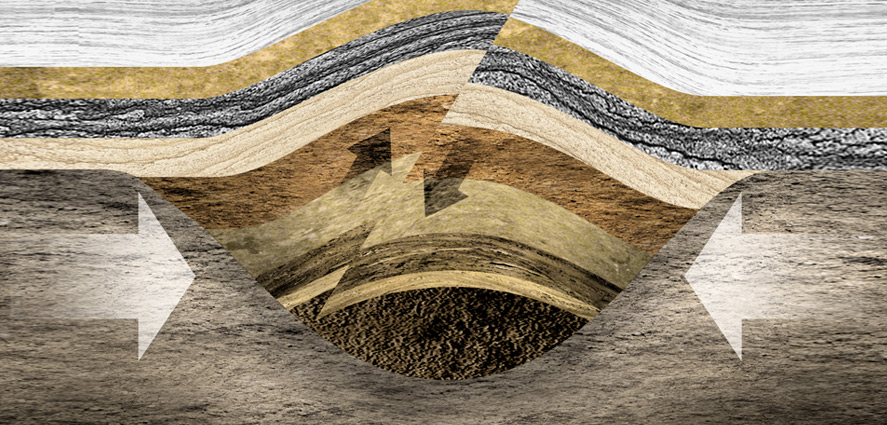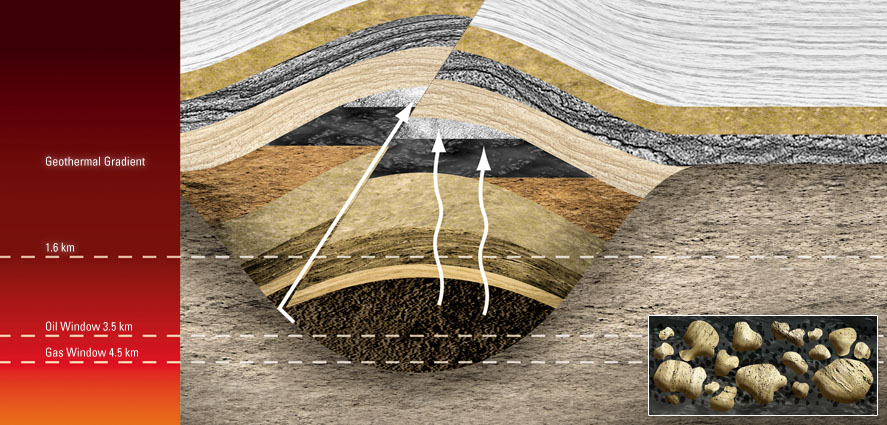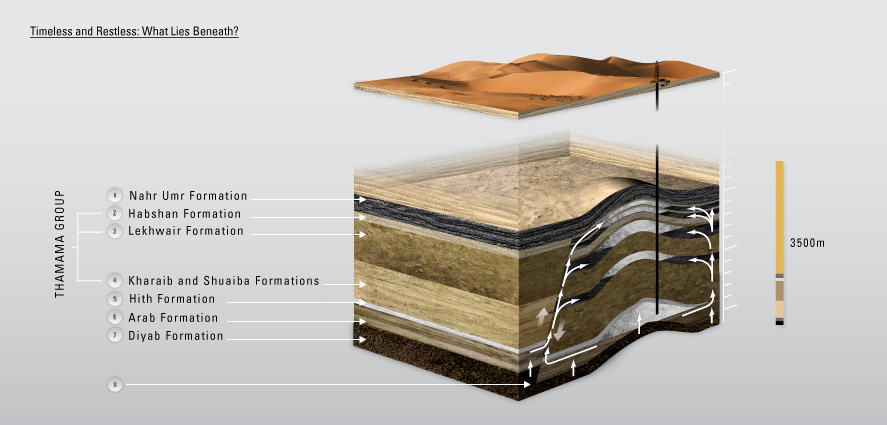
You are in :
Oil & Natural Gas Formation

The Geological Perspective

Although the Arabian Plate region has remained tectonically stable throughout the Mesozoic and Cenozoic eras (the last 251 million years), slow yet continual sinking in the east of the region has allowed the accumulation of almost ten kilometres of sediments. It is within this great thickness of sediments that the significant oil and gas resources of Abu Dhabi were formed and are trapped.
The sequence and timing of this deposition is important. Some periods favoured the accumulation of organic-rich sediments, such as mudstones and shales. These are known as source rocks and are capable of generating oil and gas (hydrocarbons). At other times, conditions favoured the deposition of sediments suitable for the storage of oil and gas, referred to as reservoir rocks. These rocks were deposited in the warm shallow waters of the ancient Tethys Sea that once covered the region (255 to 20 million years ago), in conditions similar to the Arabian Gulf today. In addition to a source and reservoir, hydrocarbon deposits require some form of seal – an impermeable rock that prevents the oil and gas from making its way to the Earth's surface and escaping.
To accumulate hydrocarbons in significant quantities, a trap is also required in which they can collect in reservoirs over time. The timing of the trap formation is important. If the trap is not in place before the hydrocarbons are generated, then the oil and gas will continue their upward journey until they are lost at the surface.
The story of oil and gas formation starts with a sedimentary basin. During times of high sea level, this depressed area may be flooded and marine sediments will be deposited. If water circulation is poor, the basin floor becomes starved of oxygen. Organic matter in the sediment will be preserved to produce organic-rich source rocks.
The weight of accumulating layers of sediment compresses the underlying sediments causing them to lithify: to form sedimentary rocks.

In Abu Dhabi hydrocarbons are found in stratigraphic and structural traps. Stratigraphic traps occur where a sedimentary rock layer prevents hydrocarbon movement. Structural traps form when sediment layers are deformed to produce a series of gentle folds with anticlines (peaks) and synclines (troughs).
Some rocks do not fold easily; they instead fracture to produce faults. Sealed faults block the movement of fluids across or along the fault: they are important in the formation of traps. Unsealing faults allow fluid migration and may breach earlier seals allowing hydrocarbons to migrate.

The temperature in the Earth increases with depth. This geothermal gradient is a major control on oil and gas formation, determining when, and if, organic-rich source rocks will generate oil or gas through the process of maturation. During burial, the rock experiences increased temperature and pressure until it enters the oil window; a time when oil is produced and migrates out of the source rock. Increasing burial will carry the rock into the gas window as a second phase of lighter hydrocarbon production.
Seals are impermeable rocks that prevent the flow of fluids, including hydrocarbons. Good seal rocks are fine-grained sediments and evaporites (chemically precipitated salts). Both types of seals occur in AbuDhabi and have a strong influence on the distribution of oil and gas.
Hydrocarbons naturally migrate upwards, travelling along any available pathways, including the pore networks within rocks, and any open faults and fractures. They may also flow laterally if the pressure of the overlying sediments prevents their upward movement. Migration continues until the hydrocarbons are either trapped in a reservoir or lost at the surface.
A potential reservoir rock must possess good porosity and permeability. Porosity describes the holes in the rock in which hydrocarbons can be stored and is recorded as a percentage of the rock's volume. Permeability allows fluids to flow through the rock and is measured in millidarcies (mD). Permeable rocks have well connected pores through which hydrocarbons can easily flow.
Timeless and Restless: What Lies Beneath?

Since the early days of oil and gas exploration, the technologies available to explore beneath the Earth's surface have improved dramatically. Seismic surveying transmits pulses of energy into the Earth to create images of the rock layers below the surface. Geoscientists study the properties of these rock layers to determine if they are likely to contain water, oil or gas. Geoscientists also lower various devices down boreholes to directly measure the physical and chemical properties of rocks. They may also extract rock sample cores. All of these analyses are used to develop detailed computer-based reservoir models and to plan the development of the oil or gas fields. These technologies allow a better understanding of the complex geology beneath the surface, allowing the development of efficient cost-effective methods for oil and gas extraction.
The Arabian Plate has remained within 30° north or south of the equator since Permian times. Warm, shallow tropical seas are ideal for the formation of carbonate sediments. Over time, these sediments accumulated to produce the thick sequence of carbonate rocks below the surface of Abu Dhabi.
Hydrocarbons are produced from more than 15 rock formations in Abu Dhabi ranging in age from the Late Carboniferous to the Miocene. However, the largest reservoirs lie within only two stratigraphic layers: the Arab Formation and the Thamama Group. Most of the traps beneath Abu Dhabi formed during the Late Cretaceous when Earth movements deformed the sub-surface sediments. Later, the collision between the Arabian and Eurasian plates during the Neogene period further developed these traps, producing the broad gentle structures that define many of the oil and gas fields of Abu Dhabi today.
Nahr Umr Formation
The clay-rich shales and mudstones of the Nahr Umr Formation were deposited in the Early Cretaceous during a period of sea level rise. These sediments overlie and seal the underlying Thamama Group reservoirs.
Thamama Group
The Thamama Group includes the Habshan, Lekhwair, Kharaib, and Shuaiba Formations-the most important hydrocarbon reservoirs in Abu Dhabi. Originating in shallow water conditions, these carbonate-dominanted sediments were deposited as rising seas flooded the Arabian Plate. High porosities and good permeabilities makes for very effective reserviors.
In western Abu Dhabi, the Arab Formation is sealed by the evaporites of the overlying Hith Formation. To the east the Hith evaporites are absent, allowing oil to migrate upward into the overlying Thamama Group.
Arab Formation
The Arab Formation was deposited at a time when Abu Dhabi was near the equator. The lower Arab Formation is dominated by limestones while the overlying layers are formed of alternating limestones and evaporites. These rocks record a time of falling sea level and the onset of conditions similar to the sabkha environments seen along the shores of Abu Dhabi today.
Diyab Formation
The Late Jurassic Diyab Formation comprises limestones and mudstones deposited during rising sea level. These organic-rich rocks are an important source of hydrocarbons. Oil production from the Diyab Formation began in the Late Cretaceous and peaked in the Palaeocene. Most of the Diyab Formation is now below the oil window and lies within the gas window.

















